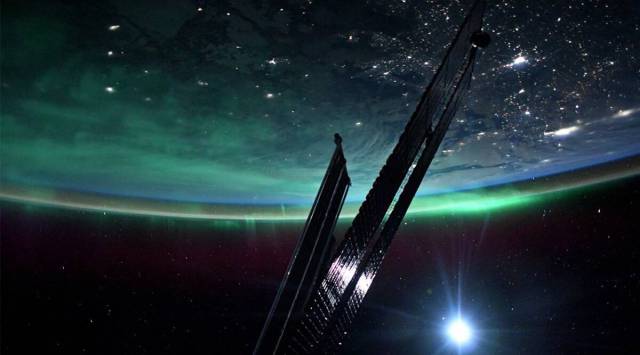Satellites capture auroras associated with carbon dioxide
Researchers have for the first time analysed data of "carbon dioxide auroras" taken from space.
 An image of an aurora captured by a NASA astronaut in March. (Image credit: Josh Cassada / Twitter)
An image of an aurora captured by a NASA astronaut in March. (Image credit: Josh Cassada / Twitter) The Northern Lights, or auroras are a phenomenon as fascinating as they are beautiful, captivating everyone from scientists to your everyday starwatchers. While they have been studied in detail, not much is known about auroras associated with carbon dioxide molecules. That might change now.
The word aurora might conjure up images of splendid green and sometimes red lights pirouetting across the sky. But auroras are associated with many different kinds of electromagnetic emissions that occur in the atmosphere. Most of these emissions are not visible to the unaided human eye.
An international team of researchers revealed global observations of auroras associated with carbon dioxide using satellites in a study published in the journal Geophysical Research Letters.
In a new study published in AGU Geophysical Research Letters, scientists unveiled global observations of aurora associated with carbon dioxide using satellite measurements.
When charged particles like electrons and protons collide with the gases in Earth’s upper atmosphere, they produce tiny flashes of colourful light, what we know as auroras. When billions of such flashes occur in sequence, that is when auroras seem to move or “dance” in the night sky.
The usually observed green and red auroras happen between 100 kilometres and 250 kilometres above the surface of the planet due to an excited state of atomic oxygen, according to Arizona State University.
But when charged particles crash into the planet’s atmosphere, they interact with many different atoms and molecules. Carbon dioxide is one of them. While the gas is known for acting as a greenhouse gas due to its presence in the lowest part of the atmosphere, trace parts of carbon dioxide also exist in the atmosphere at the edge of space.
When carbon dioxide molecules about 90 kilometres above Earth become excited during an aurora, they emit infrared radiation. This leads to more infrared radiation than is typically observed in the planet’s atmosphere.
The international team of researchers used NASA’s AIRS (Atmospheric Infrared Sounder) satellite, which gathers data on infrared energy emitted from Earth’s surface and atmosphere globally, every day.
While looking through the data, the researchers saw elevated infrared signals from carbon dioxide during an aurora. It was previously known that carbon dioxide became excited during aurora but this dataset and analysis could be the first daily global observations of regions of the northern and southern hemispheres using this kind of satellite. The measurements span a period of more than 20 years and can be used for studying aurora and energetic particle interactions in Earth’s atmosphere.







